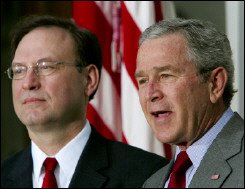Justice Alito

This morning, Samuel J. Alito was confirmed by the US Senate and was sworn in as an associate justice of the Supreme Court of the United States. As one of nine jurists who hold lifetime appointments, Justice Alito will wield power and rule on constitutional issues long after his appointing president has left office. For example, the oldest current member of the Supreme Court, John Paul Stevens, was appointed in 1975 by President Gerald Ford, now in his 90’s and recently hospitalized for pneumonia.
The hearings of the Senate Judiciary Committee on the nomination of Judge Alito, as those for now Chief Justice John Roberts before them, were largely political circuses. It was readily apparent that the only issue that democrats like Ted Kennedy, Chuck Schumer, and Dick Durbin cared about was abortion. Time after time, they tried to grill the nominees and get them to commit to a position that stated that they would never vote to overturn Roe v. Wade, the 1973 Supreme Court decision that declared all state laws regulating and prohibiting abortion to be unconstitutional. On what grounds? Justice Harry Blackmun, writing for the 7-2 majority, said that abortion was no different than birth control, and was therefore a matter of privacy between a woman and her doctor. 32 years have passed since that ruling. And still it overshadows our nation like a perpetual winter.
Until this summer and the passing of Chief Justice William Rehnquist and the retirement of Sandra Day O’Connor, there had been no vacancies on the Supreme Court for 10 years. Now President Bush has placed two reliable conservatives on the Supreme Court, and has an additional three years in office. Instead of placing on the bench justices who view the constitution as a “living document” that must change with the times and reflect a progressive agenda, conservative justices tend to be originalist in their view of the constitution. This means that they seek to interpret the constitution as it was originally intended by those who framed it, not seeking to create new rights out of “penumbras and emanations” in amendments. With Bush’s appointees, it is unlikely that the Supreme Court would advance the agenda of Justice Ruth Bader Ginsburg, who advocated that the age of consent (for sexual relations) should be lowered to twelve, that prostitution should be decriminalized, and that the celebration of Mothers’ Day should be banned because it is sexist. It is unlikely that the Supreme Court will follow the lead of the State Supreme Court of Massachusetts and suddenly decide that traditional marriage is no longer the norm and that any people who want to marry (two men, two women) should be able to do so. Instead, conservative jurists in the mold of Roberts and Alito will interpret the constitution as it was originally intended.
The debate over the Supreme court has been a clear example of the colossal struggle between traditionalism and postmodernism. We Christians approach the Bible not as a “living book” in which God’s standards for morality or his promises for eternal life as a free gift of his grace through faith in Jesus Christ are subject to change with the times. This is why it is easy to relate to the approach to justice advocated by the "right wing" of the Supreme Court. When we read the Scriptures, we seek to interpret them by examining them in their historical context to determine what the author originally intended. The word of God stands forever, even if the grass withers and the flowers fall. May God preserve his Word among us as an eternal, objective standard of ethics and morals, and, perhaps even more importantly, as the sure revelation of God’s promises of forgiveness of sins and eternal life through faith in Jesus.


<< Home